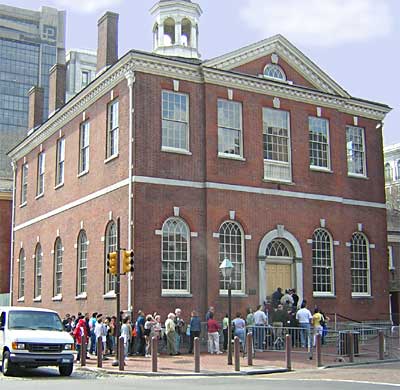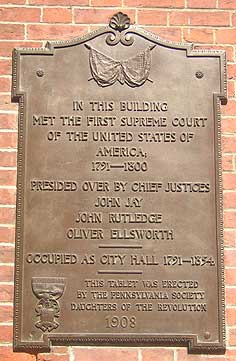Old City Hall
Home of the First Supreme Court, 1791 to 1800.

Standing in front of the Liberty Bell you'll see Independence Hall flanked by Old City Hall on the left and Congress Hall on the right. Old City Hall was Philadelphia's second city hall and served as the home of the United States Supreme Court between the years of 1791 and 1800.
Philadelphia's First City Hall
Philadelphia's original City Hall, built during William Penn's lifetime, was near the Delaware River on 2nd Street. On the ground floor was a jail. An open-air market spread west for several blocks west along High Street (Market Street today) from City Hall. Upstairs were the mayor's office and the mayor's court. Double stairs led to a balcony on the second floor. Voters handed in their ballots on the balcony. Some times Election Day got pretty wild. There were two unofficial political parties, the Proprietary Party and the Country Party — but the Country Party controlled the stairs to the balcony, so casting a vote for the Propietary Party was no easy feat!
This Was Philadelphia's Second City Hall
This building, today known as Old City Hall, was completed in 1791. No sooner had it opened than the municipal government moved in. Upstairs was the Mayor's office and the Mayor's Council Chamber. Downstairs was the Mayor's Court.

Sharing a Floor
From 1790 to 1800, Philadelphia was the Capital of the United States. And from August 1791 to February 1800, the United States Supreme Court held sessions in the courtroom on the first floor of Old City Hall, sharing space with the Mayor's Court.
Early Justices
Initially the Supreme Court was composed of a Chief Justice and 5 Associate Justices. Over the Court's first 12 years, it took 12 men to fill those 6 places. The early Supreme Court enjoyed neither the prestige nor the power that it does today. President Washington appointed the finest legal minds in the United States to the Supreme Court, but was plagued by resignations. Some appointees even turned down the "honor" of serving on the court.
Among the Court's early members were:
- John Jay. Chief Justice of the United States Supreme Court, 1789-1795. Co-author of the Federalist Papers (written to defend and explain the Constitution before it was adopted). Negotiated the controversial Jay Treaty in England. Elected governor of New York while he was out of the country. Resigned from the Supreme Court to accept that post.
- Oliver Ellsworth. Chief Justice of the United States Supreme Court, 1796-1800. Framer of the Constitution (but not a signer; he went home to attend to business). He resigned as Chief Justice in favor of a diplomatic post.
- John Marshall. Associate Justice. Admitted to practice before the Supreme Court. Became Chief Justice of the Supreme Court in Washington, D.C., in 1801.
- James Wilson. Associate Justice, 1789-1798. Signer of the Declaration of Independence and the Constitution. Other members of the Constitutional Convention said his mind was like "a blaze of light." Died in 1798 while serving on the Supreme Court.
- John Blair. Associate Justice, 1789-1796. Signer of the Constitution. He did not say one word during the Constitutional Convention.
- Samuel Chase. Associate Justice, 1796-1811. Signer of the Declaration of Independence. Impeached for partisan activities in 1804, but not convicted.
- William Paterson. Associate Justice, 1793-1806. Signer of the Constitution.
- John Rutledge. Associate Justice, Signer of the Constitution, did not attend any session in Philadelphia.
- Alexander Hamilton. Admitted to practice before the Supreme Court. Co-author of the Federalist Papers. Resigned as first Secretary of the Treasury in 1795 to practice law.
No Respect
Serving on the early Supreme Court was a strenuous and dangerous duty, due in part to the 1789 Judiciary Act authored by Oliver Ellsworth. This act compelled Supreme Court Justices to ride around the country attending Circuit Courts. Congress divided the 13 United States into 3 circuits and put two Justices in charge of each circuit. Justices often spent their nights in flea-ridden out-of-the-way inns. They spent their days traveling over dirt roads in shaky coaches.
Rivers might have been the worst part of traveling. When a Justice came to a river, he would either have to find a fording spot, cross on a ferry, or walk across on ice. Justice Chase once fell through the ice while crossing a river.
When a Justice was sick, another Justice had to take over his circuit duties. And sickness was not unusual. James Wilson died of malaria while on circuit duty in North Carolina. John Blair had to resign because a ringing and rattling sound in his ears got louder and louder and he could no longer hear the lawyers.
William Cushing was the only Justice who was able to find some relief to his hardships. He bought a coach that was as close to a camper as the 18th century could provide and talked his wife into sharing his travels.
The Supreme Court was supposed to meet in Philadelphia twice a year. However, the four justices required for an of official session were not always available. Sometimes no session could be held. No one seemed to mind all that much because there were so few important cases.
During its first and second years, the Supreme Court heard no cases whatsoever. Over the next 10 years, the Supreme Court averaged seven cases a year.
Perhaps the Court's most important early case was one where a group of South Carolina land speculators brought suit against the state of Georgia. The ruling of the Court caused such a public outcry that it resulted in the quick proposal and ratification of the 11th Amendment to the Constitution which effectively nullified the decision of the Court. The 11th Amendment relates to judicial power of the United States not extended to suits against a State: "The judicial power of the United States shall not be construed to extend to any suit in law or equity, commenced or prosecuted against one of the United States by citizens of another State, or by citizens or subjects of any foreign state."
Though the Court didn't even have its own room in Philadelphia, it was at least better than what happened when the government moved to Washington, D.C. There the justices discovered they had been forgotten and no building had been constructed for them at all! While awaiting their own building, the Congress allowed them to use a room in the basement of the Capitol building!
- Was Supreme Court of the United States from 1791-1800
- Volunteer headquarters in the battle against Yellow Fever epidemic of 1793.
- Immigration center. Thousands of immigrants entered the U.S. through Philadelphia in the last decade of the 18th century. Naturalization ceremonies for new citizens took place in this courtroom.
- In the Second Bank portrait gallery, you can see portraits of five of the Supreme Court justices who served in Old City Hall: John Jay, Oliver Ellsworth, William Cushing, Samuel Chase and Bushrod Washington. Also in the Second Bank, you can see a very large painting of Philadelphia's first City Hall (the one that used to stand on 2nd Street).
- Location: 5th and Chestnut Streets
- Built: 1790-91
- Architect: David Evans, master carpenter
- Style: Georgian
- Facilities: Guides available, benches, wheelchair accessible



